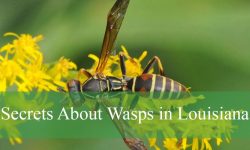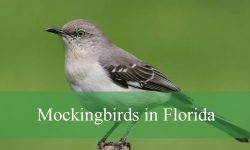Hummingbirds are some of the most fascinating birds to see in South Carolina. Their small size, colorful feathers, and rapid wingbeats make them stand out wherever they appear. Many people enjoy watching them visit flowers or feeders, especially during the warmer months.
The most common species in the state is the Ruby-throated Hummingbird, but several rare visitors from the western United States and Mexico have also been recorded. Each species has its own unique colors, behaviors, and seasonal patterns, giving birdwatchers plenty to look for.
South Carolina’s natural areas, gardens, and backyards provide good opportunities to spot these tiny birds. Whether common or rare, seeing a hummingbird is always a special moment in nature.
Types of Hummingbirds Found in South Carolina
Blue-throated Mountaingem (Lampornis clemenciae)
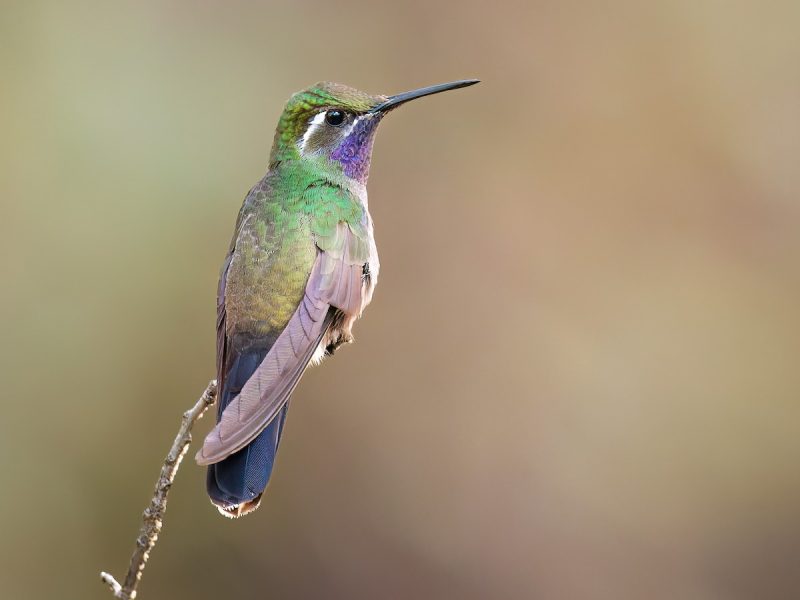
The Blue-throated Mountaingem is the largest hummingbird found in the United States, though it is extremely rare in South Carolina. Males are identified by their vibrant sapphire-blue throat, contrasting with a green back and grayish underparts. Females lack the blue throat but share the overall green and gray plumage. Their size ranges from 4.3 to 4.7 inches, noticeably larger than the Ruby-throated Hummingbird.
This species is native to the mountainous regions of Mexico and the southwestern U.S., making sightings in South Carolina highly unusual. They prefer woodland edges, canyons, and areas near streams where flowering plants are abundant. The Blue-throated Mountaingem is known for its strong flight and louder wingbeats compared to other hummingbirds.
Behaviorally, these birds are more aggressive than smaller hummingbirds. Males often guard rich nectar sources and drive away rivals with swift aerial chases. They also consume small insects, which provide protein, making them versatile feeders. Their vocalizations are sharper and more noticeable, helping with identification.
In South Carolina, this hummingbird is considered a rare vagrant, occasionally reported by keen birdwatchers. Most records are associated with late summer or fall when wandering individuals stray far from their usual range. Observing one in the state is considered a remarkable birding event.
Ruby-throated Hummingbird (Archilochus colubris)
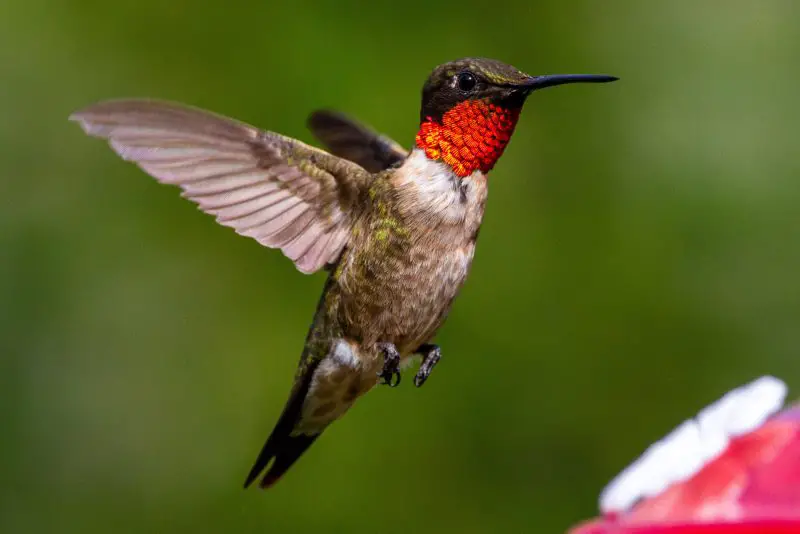
The Ruby-throated Hummingbird is the most common and widespread species in South Carolina. Males are recognized by their brilliant ruby-red throat patch, emerald-green back, and white belly, while females are plainer with green upperparts and whitish underparts. Measuring 3.5 to 3.9 inches, they are small, slender, and agile flyers.
This species breeds across the eastern United States and southern Canada, migrating to Central America for the winter. South Carolina serves as both a breeding ground and a migration stopover. They are frequently seen in gardens, meadows, and woodlands, especially where tubular flowers and hummingbird feeders are available.
Ruby-throated Hummingbirds are known for their rapid wingbeats, hovering flight, and aggressive defense of nectar sources. They supplement their diet with insects such as gnats, mosquitoes, and small spiders, which provide essential nutrients for survival. Their courtship displays involve aerial dives and unique vocal sounds.
In South Carolina, they are most abundant from late spring through early fall. They are regular visitors to backyard feeders, making them one of the most familiar hummingbird species for residents. Their adaptability to human environments ensures their continued presence in the state.
Black-chinned Hummingbird (Archilochus alexandri)

The Black-chinned Hummingbird is a rare but occasional visitor to South Carolina. Males feature a black throat with a narrow iridescent purple band that becomes visible in sunlight, while females are more subdued with pale underparts and green upperparts. They measure about 3.5 to 3.9 inches, similar in size to the Ruby-throated Hummingbird.
This species typically inhabits the western United States, where it thrives in deserts, river valleys, and scrublands. In South Carolina, sightings are rare and usually occur during migration or winter. Their subtle markings can make them difficult to distinguish from the Ruby-throated, but the darker throat and slimmer build provide key identification clues.
Black-chinned Hummingbirds are known for their adaptability to diverse habitats and their high-pitched vocalizations. They feed primarily on nectar but also consume insects to balance their diet. During breeding season, males perform impressive courtship displays, diving in wide arcs to attract females.
Although not a regular resident, this species has been documented visiting feeders and flowering plants in South Carolina. Their rarity makes them a sought-after species for local birders, especially during migration periods when unusual visitors may appear.
Anna’s Hummingbird (Calypte anna)

Anna’s Hummingbird is another rare but increasingly observed hummingbird in South Carolina, thanks to its expanding range. Males display a striking rose-pink gorget and crown, which shimmer brilliantly in sunlight, while females show a smaller splash of pink on the throat. With a length of about 3.9 to 4.3 inches, they are slightly larger than Ruby-throated Hummingbirds.
This species is native to the West Coast of North America, where it thrives year-round in urban areas, gardens, and chaparral habitats. Occasional records in South Carolina usually occur during winter, when individuals wander beyond their typical range. Their colorful plumage and larger body size make them relatively easy to identify when compared to other vagrants.
Anna’s Hummingbirds have unique behavioral traits, including their remarkable vocal abilities. They are among the few hummingbirds that sing, producing scratchy, buzzy notes in addition to their rapid wing sounds. Males also perform spectacular courtship dives, plummeting from heights to impress potential mates.
In South Carolina, Anna’s Hummingbirds are most often reported at backyard feeders during the cooler months. While still considered unusual, their presence has increased in the eastern United States, suggesting that birdwatchers may see them more frequently in the future.
Calliope Hummingbird (Selasphorus calliope)
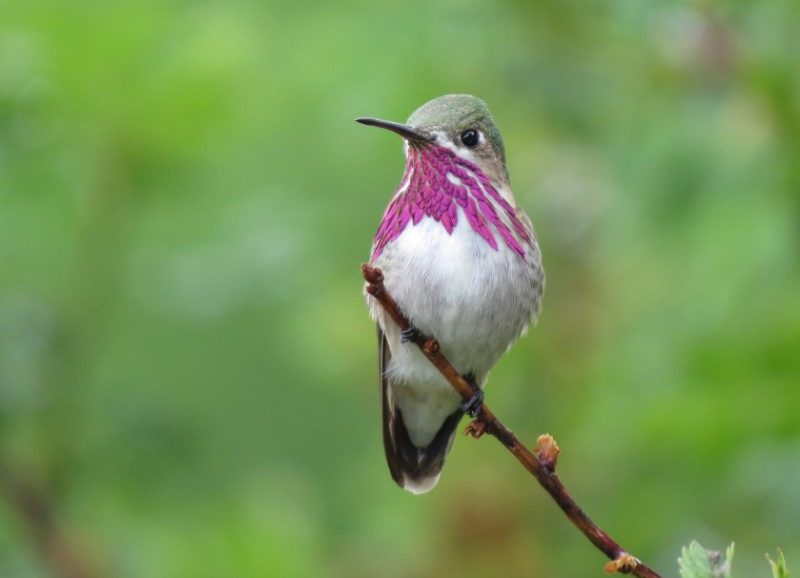
The Calliope Hummingbird is the smallest bird in North America, measuring only 3.1 to 3.5 inches. Males are recognized by their striking magenta streaks on the throat, which flare outward like rays, while females and juveniles are duller with greenish upperparts and whitish underparts. Their tiny size makes them particularly distinctive.
Native to the western United States, this species breeds in mountain meadows before migrating south to Mexico for winter. In South Carolina, they appear as rare winter visitors, often recorded at feeders maintained by dedicated hummingbird enthusiasts. Their presence in the state is notable due to their long migratory journeys.
Calliope Hummingbirds feed on nectar from small tubular flowers and also capture insects in midair. Despite their small stature, they are surprisingly aggressive when defending food sources. Males engage in territorial chases and courtship displays, showcasing their speed and agility.
Although rare in South Carolina, sightings of the Calliope Hummingbird are increasing as birdwatchers maintain feeders through the winter. Their unique size and brilliant throat markings make them a memorable addition to the list of hummingbirds recorded in the state.
Rufous Hummingbird (Selasphorus rufus)
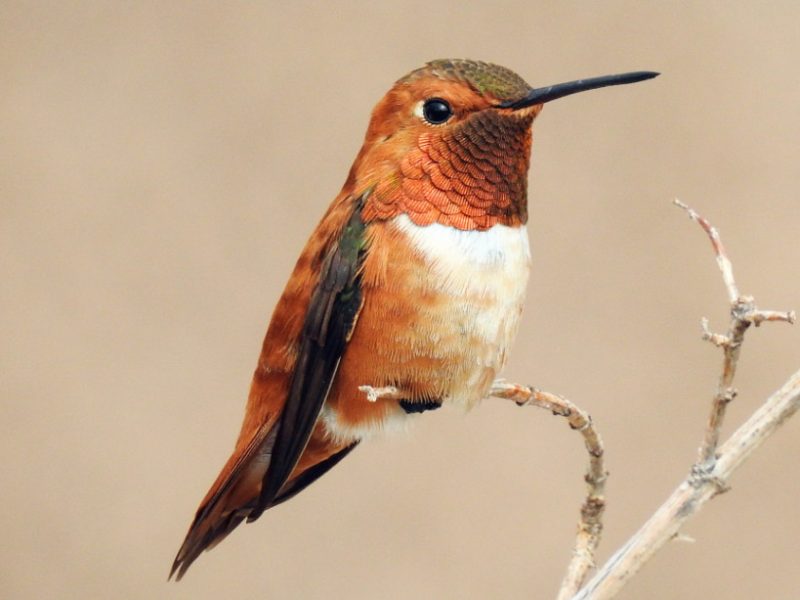
The Rufous Hummingbird is one of the most striking hummingbirds to appear in South Carolina, though it is not a permanent resident. Males are distinguished by their vivid orange-rust plumage with a shimmering red throat, while females have green backs with rufous flanks and tails. Measuring 2.8 to 3.5 inches, they are small but highly noticeable due to their bold coloring.
This species breeds primarily in the Pacific Northwest and Alaska, migrating to Mexico for winter. In South Carolina, they are typically observed during late fall and winter, often lingering at feeders left up by homeowners. Their hardy nature allows them to withstand colder conditions better than many other hummingbird species.
Rufous Hummingbirds are known for their feisty and territorial behavior. Despite their small size, they often dominate nectar sources, chasing away even larger hummingbirds. They supplement their diet with insects and spiders, especially during migration when extra protein is essential.
Birdwatchers in South Carolina consider Rufous Hummingbird sightings a seasonal highlight. Their fiery plumage and combative personality make them one of the most memorable hummingbirds to visit the state.
Allen’s Hummingbird (Selasphorus sasin)
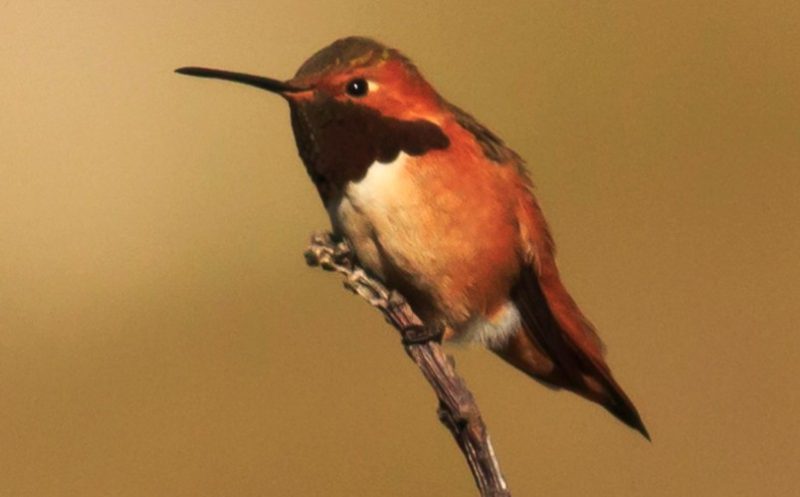
Allen’s Hummingbird closely resembles the Rufous, but with subtle differences that can be difficult to detect in the field. Males have a bright orange body with a metallic red throat, but unlike Rufous males, they typically have more green on the back. Females are mostly green above with rufous sides and tail feathers. Their size is about 3.5 inches.
This species is native to coastal California and southern Oregon, making sightings in South Carolina extremely rare. Most reports occur during winter, when wandering individuals appear far outside their usual range. Careful observation is required to separate them from Rufous Hummingbirds.
Behaviorally, Allen’s Hummingbirds are just as aggressive as Rufous, frequently chasing away rivals from feeding spots. Their rapid wingbeats and territorial dives are characteristic behaviors that make them stand out. Like most hummingbirds, they rely on both nectar and small insects for survival.
In South Carolina, Allen’s Hummingbird is considered a vagrant species. Birders who spot one often document the sighting carefully, since misidentifications are common. Their rarity makes them a prized discovery for local enthusiasts.
Broad-tailed Hummingbird (Selasphorus platycercus)
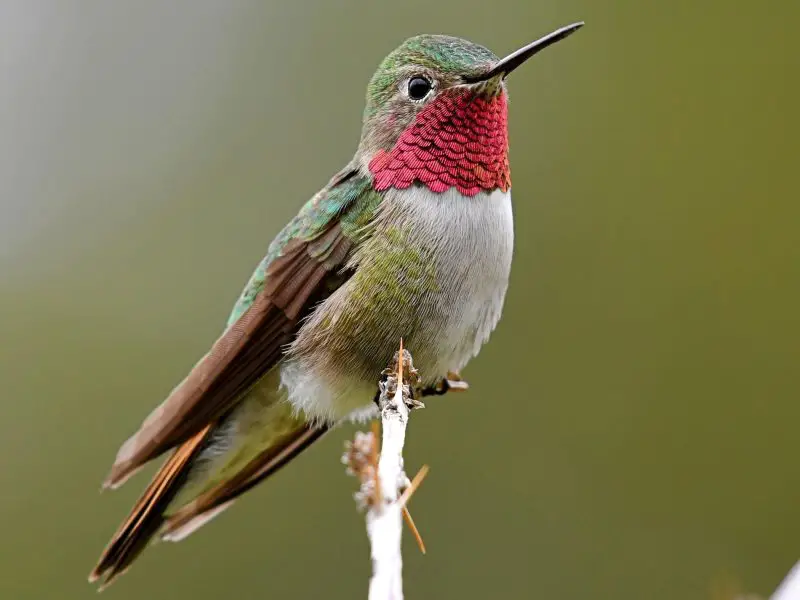
The Broad-tailed Hummingbird is recognized by the male’s rose-red throat patch and metallic green back. Females are paler with green upperparts and buffy sides, lacking the male’s throat coloring. Both sexes are known for their long tails with rounded tips, which give the species its name. They measure about 3.5 to 4 inches in length.
This species is native to the Rocky Mountains and western U.S., where it breeds in high-altitude meadows and open woodlands. In South Carolina, it is considered a very rare visitor, usually appearing during migration or winter months. Its presence in the state is remarkable, given the distance from its normal range.
A unique feature of the Broad-tailed Hummingbird is the male’s wing sound. As they fly, their wings produce a distinctive metallic trilling noise, which can be heard even without seeing the bird. This trait makes them easier to identify when observed in flight.
Although extremely rare in South Carolina, occasional records exist of Broad-tailed Hummingbirds at feeders. Birdwatchers familiar with their unique sounds and throat coloration have the best chance of confirming sightings.
Broad-billed Hummingbird (Cynanthus latirostris)
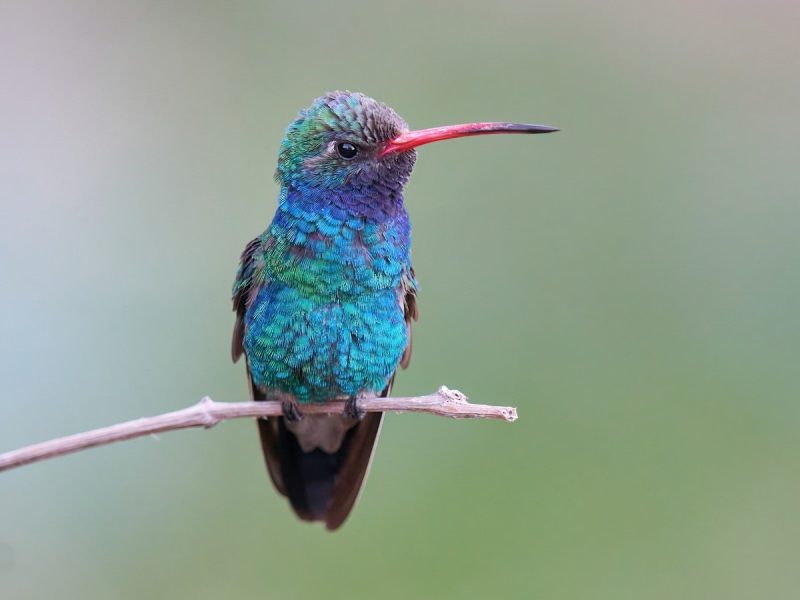
The Broad-billed Hummingbird is one of the most colorful species occasionally reported in South Carolina. Males have a glittering green body, blue throat, and a distinctive bright red bill with a black tip. Females are duller but still retain the red bill, making identification possible. Their average size is 3.1 to 3.9 inches.
This species is native to Mexico and the southwestern United States, especially Arizona and New Mexico. Sightings in South Carolina are extremely rare, with only a handful of records. They are typically found near feeders or in areas with abundant flowering plants.
Broad-billed Hummingbirds are active and agile, often hovering low to the ground as they feed. Their striking coloration makes them one of the easiest hummingbirds to recognize, especially the male’s vivid red bill, which sets them apart from other species.
In South Carolina, the Broad-billed Hummingbird is considered a vagrant species. Birders who encounter one are witnessing a rare and exciting occurrence, adding to the diversity of hummingbird records in the state.
Buff-bellied Hummingbird (Amazilia yucatanensis)
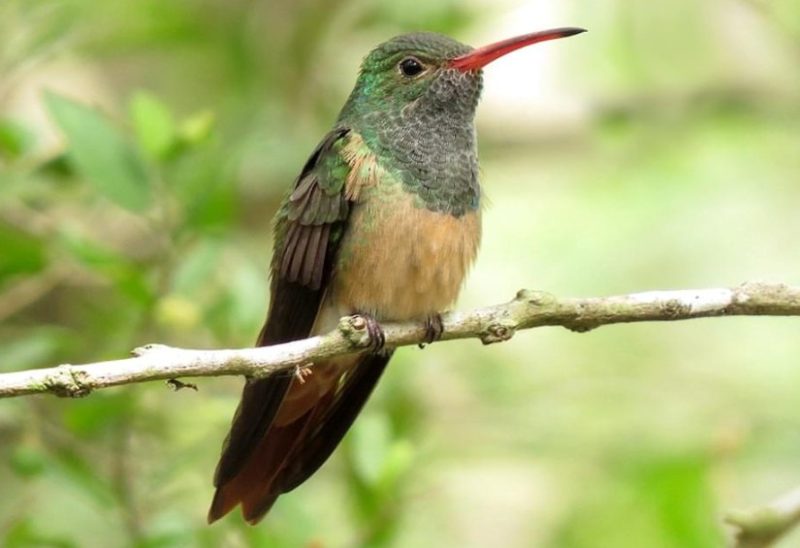
The Buff-bellied Hummingbird is a larger and more robust species compared to most others recorded in South Carolina. Males and females are similar in appearance, with metallic green upperparts, a buff-colored belly, and a reddish bill tipped with black. Their size ranges from 3.9 to 4.3 inches.
This species is native to Mexico and the Gulf Coast of Texas, where it breeds and winters. In South Carolina, sightings are very rare and generally occur during the cooler months, often at well-maintained feeders. Their unique buffy underparts help distinguish them from other hummingbirds.
Buff-bellied Hummingbirds are known for their more tolerant behavior compared to aggressive species like Rufous. They still defend food sources but often feed alongside other hummingbirds without constant chases. Their diet includes nectar from native flowers and insects caught in flight.
In South Carolina, the Buff-bellied Hummingbird is a prized find for birdwatchers. Their size, coloration, and rarity make them one of the most exciting vagrant hummingbirds documented in the state.
Best Times and Places to Observe Hummingbirds in South Carolina
The best time to observe hummingbirds in South Carolina is from late March through early October, when Ruby-throated Hummingbirds are abundant. They arrive in spring after migrating across the Gulf of Mexico, and their numbers peak during summer as they breed and raise their young. By late September, most begin their southward migration, but rare western species may appear in fall and linger into winter.
For reliable viewing, backyard feeders are excellent locations, especially when filled with sugar-water nectar (a 4:1 water-to-sugar ratio). Hummingbirds are also drawn to native flowering plants such as trumpet creeper, bee balm, and cardinal flower. Rural gardens, suburban yards, and forest edges all provide opportunities to see these fast-moving birds.
Birders hoping to spot rare vagrant species should keep feeders up through the winter months. While Ruby-throated Hummingbirds usually migrate away, species like Rufous, Calliope, and Anna’s Hummingbirds occasionally remain or pass through. Patience and consistent observation greatly improve the chances of seeing uncommon visitors.
FAQs About Hummingbirds in South Carolina
What is the most common hummingbird in South Carolina?
The Ruby-throated Hummingbird is by far the most common species in the state. It breeds here in large numbers and is regularly seen at gardens, parks, and feeders from spring to fall.
Can hummingbirds be seen in South Carolina during winter?
Yes, although Ruby-throated Hummingbirds migrate south, several rare species such as Rufous, Calliope, and Anna’s Hummingbirds are sometimes observed at feeders during the colder months.
Where are the best places to see hummingbirds in South Carolina?
Backyard gardens with nectar feeders and flowering plants are the most reliable spots. Natural habitats like forest edges, meadows, and river valleys also provide excellent viewing opportunities.
How can I attract hummingbirds to my yard in South Carolina?
Planting native nectar-rich flowers such as trumpet creeper, bee balm, and salvia will naturally attract them. Keeping clean nectar feeders filled with sugar water also ensures frequent visits.
Are hummingbirds aggressive toward each other?
Yes, many hummingbirds are highly territorial and will chase rivals away from food sources. This is especially true for species like Rufous Hummingbirds, which are known for their combative behavior.


